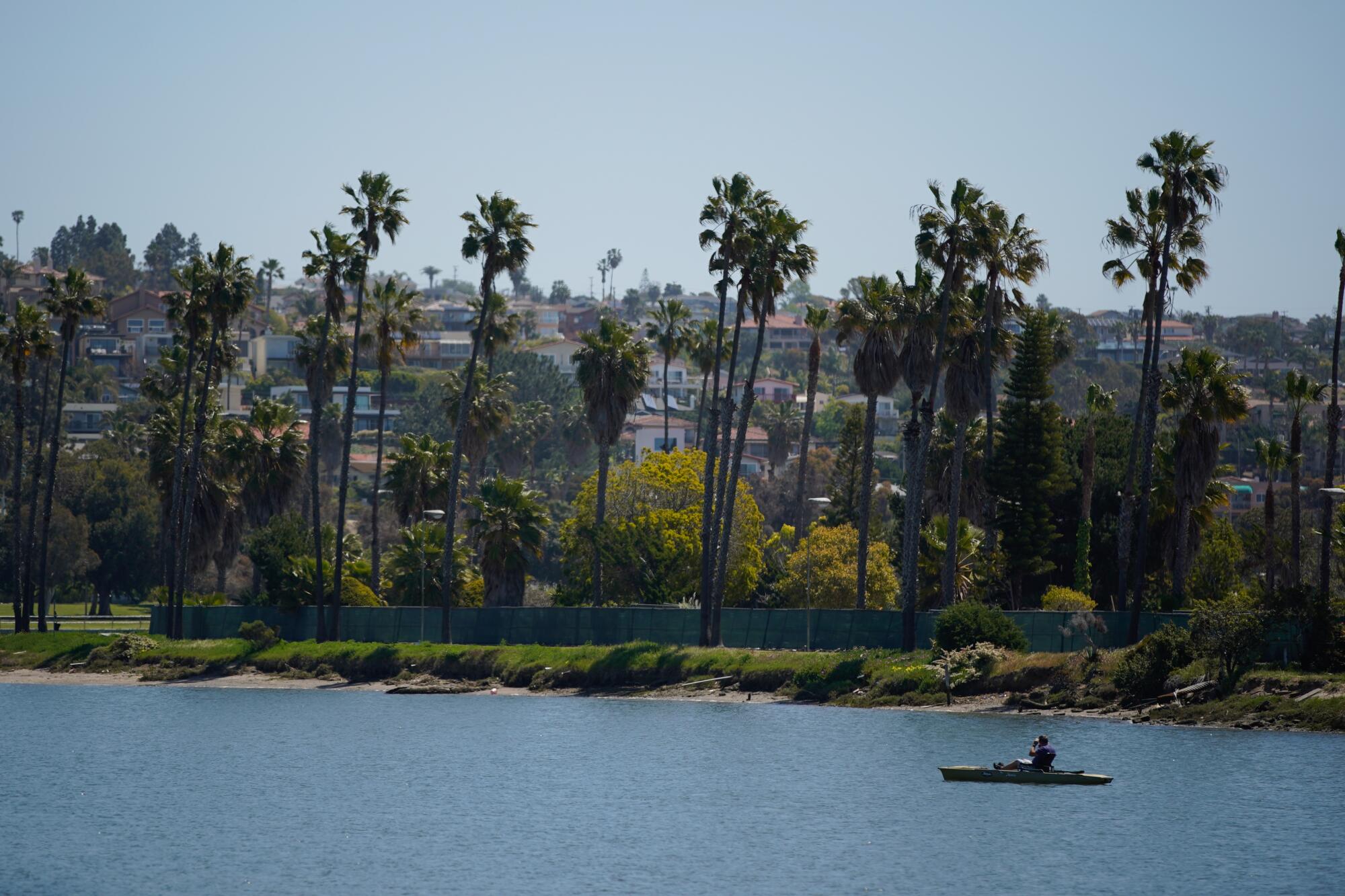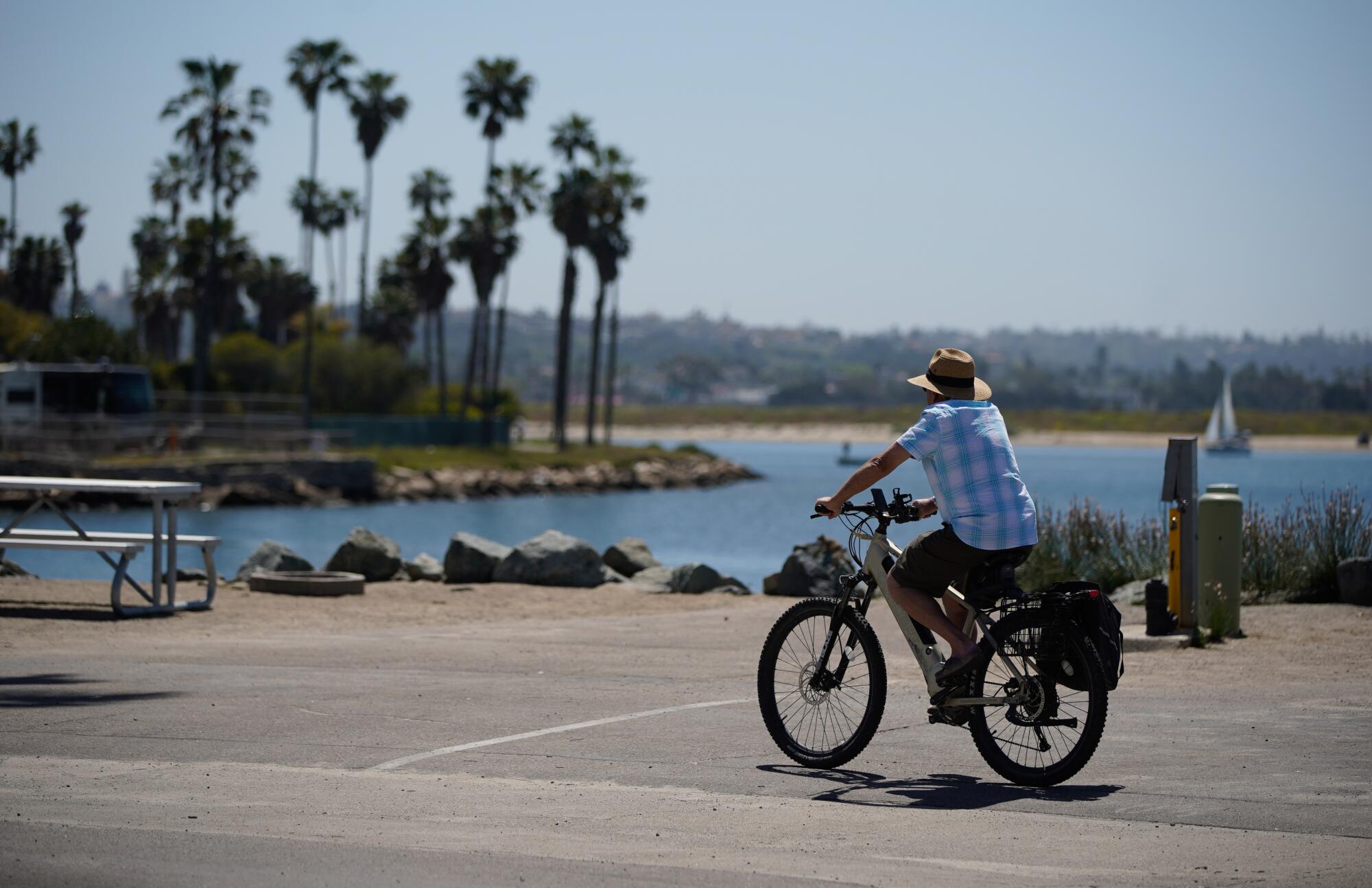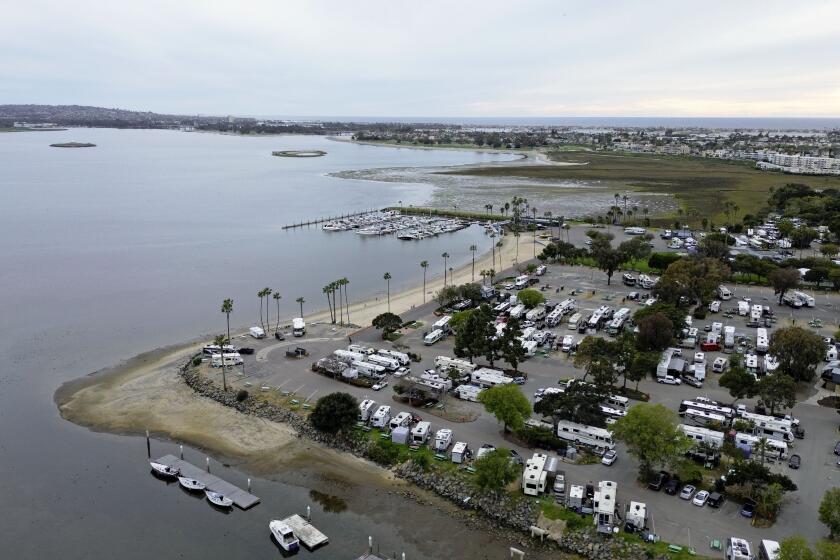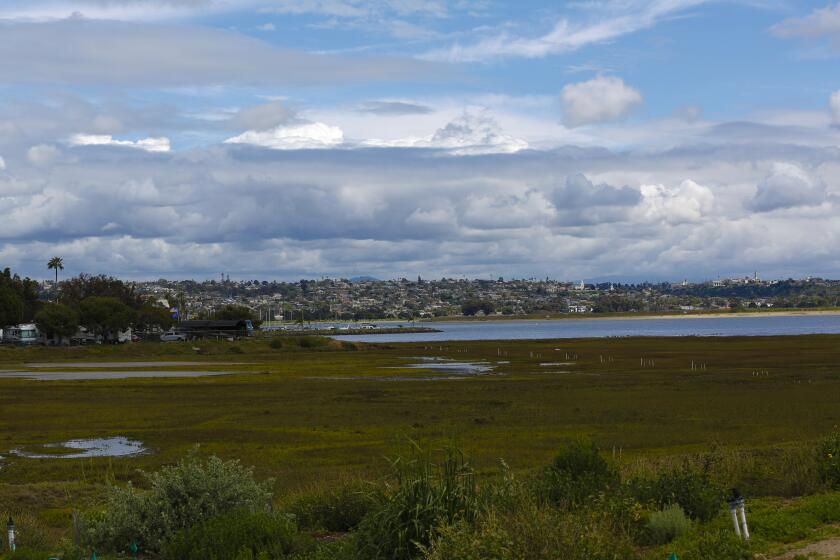
- Share via
SAN DIEGO — San Diego’s plan to transform much of recreation-rich northeast Mission Bay into marshland is facing a powerful backlash this spring from tennis players, golfers, boating clubs, campers and supporters of youth sports.
They say the city’s plan to replace some recreational areas with hundreds of acres of climate-friendly marshland threatens vital local institutions that have been part of San Diego’s civic fiber for more than 50 years.
This story is for subscribers
We offer subscribers exclusive access to our best journalism.
Thank you for your support.
Those institutions include Campland by the Bay, the Mission Bay Golf Course, the Pacific Beach Tennis Club, Bob McEvoy Youth Fields and the Mission Bay Boat & Ski Club.
The groups don’t dispute that marshland can boost water quality, pull carbon out of the air and help fight sea-level rise and its impacts. But they say city officials haven’t properly weighed the pros and cons of the plan, particularly its impact on recreation.
The outpouring of opposition, which has included critics flooding two public meetings and submitting more than 1,000 written comments, comes during the final stretch of a seven-year process to determine the fate of the area.
That process was sparked by the long-awaited closure of the De Anza Cove mobile home park, which freed up 75 acres of land and created the potential for city officials to re-envision the entire northeast corner of Mission Bay.
Officials also revised their latest proposal, boosting land for active recreation and adding a third public beach
City officials last month unveiled Mayor Todd Gloria’s preferred plan for the 505-acre area, which would triple marshland and dune areas from 82 acres to 257 acres and shrink the acreage available for other activities.
Space for camping would shrink from 62 acres to 48 acres, space for passive recreation like picnicking would drop from 89 acres to 31 acres, and space for active recreation like tennis, golf and baseball would shrink from 66 to 60 acres.
Those reductions are particularly frustrating to many people who rely on the area for recreation because they had expected the elimination of the mobile home park to open new opportunities — not reduce them.
They say it’s a particularly bad time to consider shrinking recreation opportunities in the area, which is just west of a new trolley line that city officials have targeted for high-rise residential development and many thousands of new residents.
Critics also complain that city officials have declined to say which recreational activities will survive and which will be forced out of the area — or be uprooted and forced to relocate elsewhere within northeast Mission Bay.

City officials say they aren’t being intentionally vague but rather envision such decisions as part of a two-step process.
The City Council is scheduled this fall to approve a concept plan designating which areas will be devoted to marshland, camping and recreation. In coming years, the council will specify which activities will occupy the recreation areas and precisely where they’ll be.
To appease recreation groups demanding to know their fate more quickly, city planner Scott Sandel recently unveiled a “test fit” map he created to show that all existing activities could survive in northeast Mission Bay except the boat and ski club.
His map shrinks the golf course from 47 to 43 acres, reducing it from a par-58 to a par-54 and making the driving range smaller. In exchange, the number of sports fields could grow from four to five and the number of tennis courts could jump from eight to 10.
“The area is envisioned to remain a recreational hotspot, offering a variety of active sports and recreation facilities,” Sandel wrote in a city staff report. “Examples could include golf facilities, tennis courts and ball fields.”
While his map was welcome news, critics stressed that it’s not a written guarantee their activity of choice will survive. They also stress that the sports fields and tennis courts would have to relocate, potentially interrupting their availability for significant stretches of time.
Such concerns and the fact that the city hasn’t specified which recreational uses will survive prompted the San Diego Parks and Recreation Board on Thursday to approve a special subcommittee to explore solutions and prospects for delaying the process.
Battle continues over balance in park’s northeast corner between recreation, nature
“This is a 50-year plan, and it doesn’t seem to be completely worked out to everyone’s satisfaction,” board chair Marcella Bothwell said. “I don’t feel it’s ready for prime time yet.”
Board member Dennis Otsuji said he prefers a previous plan for the area unveiled in 2018 that he thought had a better balance between marshland and recreation. That proposal included 120 acres of wetlands combined with more acres for camping and recreation.
Board member Shaina Gross said one issue that needs to be settled is whether the Boat & Ski Club will be allowed to relocate out of northeast Mission Bay to the bay’s south shore.
“It feels like we’re rushing,” she said. “There’s clearly a lot of input, and I think we could get to a place that’s more of a middle ground.”
The special subcommittee will include three members from that board and three members of the Mission Bay Park Committee, which expressed similar concerns during an April 4 meeting where 400 people spoke against the city’s plan.
The committee’s complaints about the vagueness of the city plan prompted the test fit map.
At Thursday’s Parks and Recreation Board meeting, dozens of critics complained about the city’s plan.

“I can’t emphasize strongly enough the immense value and crucial role of the Bob McEvoy youth fields,” said resident Susan Crowers. “Participation in youth sports provides immediate and long-term physical and mental benefits for youth, their families and the community. The youth of Pacific Beach, Clairemont and La Jolla all share these fields year-round for baseball, softball, tee ball and soccer.”
Gary Kent, who uses the area’s tennis courts, said he’s worried city officials in the future won’t keep the promises of their predecessors.
“We want to make sure there’s no ‘oops’ later,” he said. “We also want the club to stay open. We don’t want it to be knocked down and rebuilt somewhere else a few years later.”
Ann Dynes said the golf course, tennis courts and sports fields are far enough away from the water that they should not be considered part of Mission Bay Park, making them exempt from this process. Other golf supporters stressed that the Mission Bay course serves as a practice course for many young local golfers.
Local golfers are rallying to save iconic Mission Bay Golf Course from being reconfigured, reduced to nine holes or eliminated altogether to make way for restored marshland, camping and recreational amenities.
Supporters of the Boat & Ski Club also stressed its value to young people and low-income residents. Storage fees for boats there are $80, among the lowest in the region. And the club hosts dozens of free events, including kayak clinics.
Many of those criticizing the city’s plan wore bright yellow shirts that said “Campland Forever.” They said the 54-year-old campground, which has a pool and outdoor concert space for campers, is a cherished spot for thousands of Southern California families.
“The conversation that’s taking place is premature,” said Ken Wagner, who has visited Campland 11 years in a row. “It just doesn’t make sense to reduce it. Let Campland do what they do best — make campers happy and generate revenue for the city.”

Campland generates more than $5 million a year for the city in lease revenue. City officials haven’t provided updated revenue estimates for the other recreation activities in northeast Mission Bay.
Jacob Gelfand, whose family runs Campland, said it would make more sense to restore wetlands in other parts of the city.
Aware of the backlash, environmental groups that persuaded the city to prioritize marshland are lobbying officials to stick with the plan, or possibly add more marshland.
They held a news conference Wednesday stressing that the city’s plan would still create only 75% of the marshland needed, contending that sea-level rise will put much of the park and the new marshland in the plan completely underwater by the year 2100.
Because of such concerns and the ability of marshland to help remove carbon from the atmosphere, the city’s climate action plan calls for creating 700 new acres of new marshland by 2035. Officials say the northeast corner of Mission Bay is a key part of that city commitment.
City officials say they plan to return to the Mission Bay Park Committee in June and the Parks and Recreation Board in July. They have a tentative hearing date of Aug. 31 before the city’s Planning Commission, with a City Council hearing expected sometime in the fall.
Whatever plan the council chooses will need to be submitted to the California Coastal Commission for approval.
More to Read
Sign up for Essential California
The most important California stories and recommendations in your inbox every morning.
You may occasionally receive promotional content from the Los Angeles Times.













